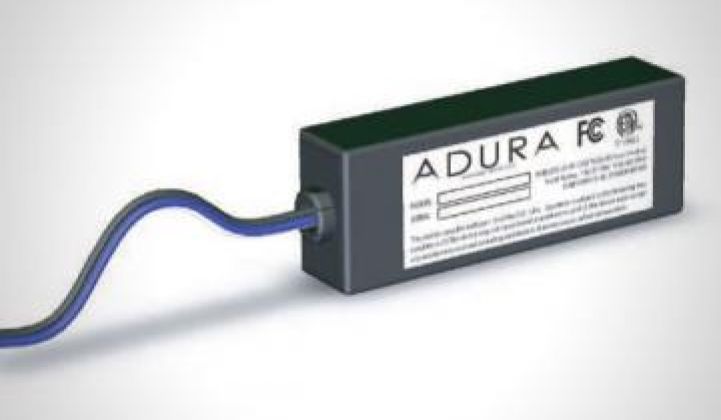Adura Technologies, one of the early entrants into lighting networking, has been dark for a while.
In 2009, then-CEO Jack Bolick unfurled the company’s products and vowed that by 2014, Adura’s wireless controllers would manage the lighting for 100 million square feet of commercial real estate. Early trials with PG&E demonstrated that the technology could reduce the power consumed by lights by nearly 73 percent.
Adura even talked about expanding beyond lights into controlling heaters, air conditioners and other appliances.
Then came the rough patch. In 2010, Bolick was ousted, investors started to bring in new management, competitors like Redwood Systems and Daintree Networks began to pop up and the technology needed to be overhauled. More recently, co-founder Zach Gentry departed for competitor enLighted (sic).
Adura remains far from the 100-million-square-feet milestone, but it has definitely made strides, according to Mark Golan, who left Johnson Controls to become Adura’s CEO in March. The company’s technology controls the lights illuminating 2.7 million square feet of commercial real estate. Considering that only around one percent of California office buildings even sport lighting controls, that figure makes Adura a major player.
The latest customer is Hills Plaza in San Francisco. The owner put Adura’s technology into its parking garages and recommends it to tenants. Google and the U.S. Secret Service have agreed to put the technology into their office suites at Hills. (Is this a prelude to a merger between the two organizations?)
On average, the technology reduces the electricity dedicated to lighting by 45 percent, Golan said. Lighting accounts for around 25 percent of the energy consumed in commercial buildings, second only to heating and air conditioning. Better lighting control, meanwhile, also means less heat and less need for AC.
Some customers with offices designed to maximize day lighting have seen savings closer to 70 percent. The return on investment in a relatively optimal situation can be as low as three years. HVAC controls for now are shelved: Adura will stick with lighting, Golan emphasized.
The technology overhaul has also trimmed the cost and improved the effectiveness of the system, says CTO Andy Wheeler. (Wheeler previously worked at Tendril and Ember and invented the embedded technology used in Zipcar.)
Adura’s technology uses ZigBee modules. Individual modules are attached to fluorescent or LED light fixtures; these speak to other gateways and controllers and other devices that try to orchestrate lighting in a building.
Early versions of the gateway could only manage 50 light fixtures at time. While that sounds like a lot, it isn’t. Look overhead. U.S. office ceilings are heavily populated with separate light fixtures. In a large building, the number of gateways required would balloon the budget: the hardware is cheap, but the bill for installation and ongoing commissioning can be high.
The new gateway can manage 250 light fixtures. “We are covering most floors with one or two gateways. We will get to 1,000,” said Wheeler. “The hardware was in need of some redesign.”
The company still has a long way to go. So far, around one-third of Adura’s deployments involve parking garages. Only 500,000 square feet of office space has been colonized. Thus, the company hasn’t fully cracked the majority segment of commercial real estate.
Commercial landlords and tenants also still pucker when asked to invest in efficiency. Cisco recently announced it would exit the market for building management tools: it only entered the space in 2009. Efficiency tools save money, but many remain wary about the initial investment. Efficiency-as-a-service companies like Transcend Equity and Metrus Energy are trying to take the sting out of it. Adura may have to tout itself more as a service to get more traction.
Lighting controls, historically, also have something of a snake oil reputation. More trials will be needed. Lighting controllers will also have to work with architects. The layout of an office has a huge impact on lighting efficiency. If you choose blond woods and low-slung cubicles, you can harvest far more sunlight.
On the plus side, the so-called “split responsibility” problem -- tenants benefit from the technology but landlords pay for it -- seems to be dissipating. Large tenants will often lease spaces for five years. If the technology can pay for itself in three years, tenants are more willing to invest, according to Golan.
Interest in LEDs will also boost sales. Although Adura was initially targeted as a way to control fluorescent fixtures, it works with LED technology. “The industry has capitulated” to LEDs, said Golan. New fixtures, like Cree’s latest ceiling lamp, are helping drive down the price. Manufacturers will install Adura’s technology at their own factories to cut down on onsite labor.
Finally, acquisitions could spur the market. We’ve been waiting to see companies like Adura, Lumenergi, Daintree, Redwood, Lumetric get swept up by established giants. Johnson Controls, Siemens, Honeywell and other traditional building control companies understand HVAC, but not lighting. Lighting literally remains the last frontier for energy management in office buildings. Imagine if your heater only had two modes: full-blast and off. That is what lighting is like in most buildings.
“It is very different,” Golan said. “They are looking closely at it and will use partnerships and acquisitions.”



